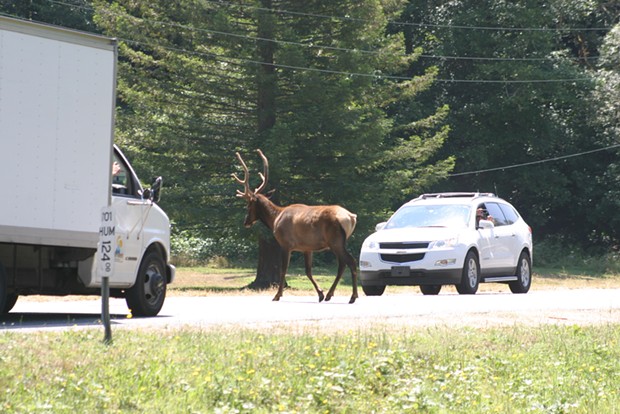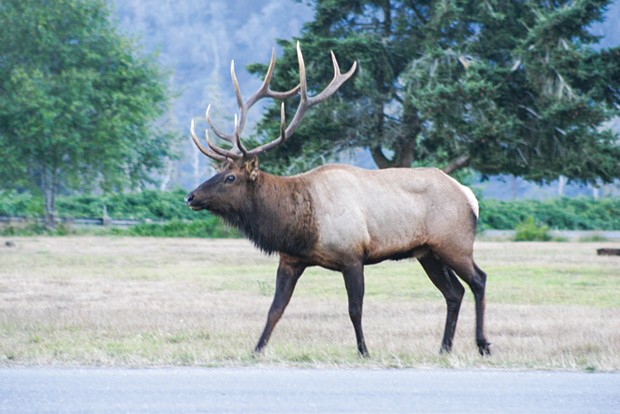Elk Crossing
Agencies look to protect famous herd while leaving them free to roam
By Kimberly Wear [email protected] @kimberly_wear
Photo by Micaela Szykman Gunther
A section of U.S. Highway 101 around the Little Red Schoolhouse and Stone Lagoon south of Orick has the highest concentration of elk crossings in coastal Humboldt and Del Norte counties.
[
{
"name": "Top Stories Video Pair",
"insertPoint": "7",
"component": "17087298",
"parentWrapperClass": "fdn-ads-inline-content-block",
"requiredCountToDisplay": "1"
}
]
A herd of Roosevelt elk living around Stone Lagoon has been getting a lot of attention lately.
It's not the usual adoration heaped upon the animals from tourists driving along U.S. Highway 101 near Stone Lagoon who are taken in by the frequent sight of bulls bearing candelabra-esque antlers grazing in a sunlit meadow with their so-called "harems" against the scenic backdrop of the Little Red Schoolhouse, which gave the herd its name.
But that draw, unfortunately, happens on a stretch of road without safe places to pull over, causing motorists to sometimes make unsafe maneuvers. Combined with the herd's penchant for traversing 101 in a series of nearby spots along a narrow, curving 1-mile section of the roadway that divides its territory, it creates a dangerous scenario that puts both elk and people at risk.
"We found this stretch of road ... to be a hotspot of crossings, in addition to bottlenecking and collisions," said Cal Poly Humboldt Wildlife Department professor Miceala Szykman Gunther, who is working with the California Department of Fish and Wildlife and Caltrans to place an experimental elk detection and warning system in the area.
To that end, wildlife biologists have been remotely tracking the herd's movements using location transmitters already in place on previously collared elk — looking not to answer the question of why do the elk cross the road but how long it takes them to get to the other side, and how long they tend to linger along the highway's edges before wandering over.
The idea behind the detection and warning system is simple: The transmitters on the collars will use ultra-high frequency signals —similar to Wi-Fi or Bluetooth — to activate signs installed at the northern and southern ends of a 1-mile section of roadway with the Little Red Schoolhouse in its center to flash warning messages for approaching motorists whenever the animals are within a certain distance of the roadway.
Once installed sometime next year, the system will be the first of its kind in California.
And the elk aren't the only ones under observation. The speeds of motorists driving in the area are also going to be monitored and will continue to be after the system is in place to see if the signs are effective in slowing traffic, Szykman Gunther said.
While the Caltrans-funded project currently focuses on this particular stretch of road that's within the territory of a particular group elk — known as the "Red Schoolhouse Herd" — Szykman Gunther said the hope is to eventually expand the system to other crossing hotspots if it proves successful.
Just this year, at least four crashes involving the Red Schoolhouse Herd have been reported in the study area, including one that occurred recently. All have been fatal for the elk. Last year, five elk-involved crashes were recorded in the area.
"It's a dangerous spot," Szykman Gunther said.
That's among the reasons why CDFW has designated 13 miles of U.S. Highway 101 encompassing that stretch as one of the 12 areas of highest concern in the state for collisions involving wildlife, according to a 2020 analysis and an updated report, "Restoring California's Wildlife Connectivity," released this summer.
The latest report notes the Safe Roads and Wildlife Protection Act passed by the Legislature last year now requires "Caltrans to identify barriers to wildlife movement and prioritize crossing structures when building or improving roadways."
"Achieving meaningful progress will take time, funding and effort," the report states. "We look forward to working in close partnership with our colleagues at the federal, state, local levels, as well as tribal nations, and interested stakeholders to restore wildlife connectivity throughout the state."
Caltrans District 1 also recognizes the roadway around the Little Red Schoolhouse as a high priority for addressing crashes involving elk, with the area designated as as the No. 1 spot for wildlife-vehicle collisions in all of Del Norte, Humboldt and Mendocino counties. In 2020, the agency received a grant to study the feasibility of building a wildlife-dedicated bridge over the highway south of Stone Lagoon that could potentially give elk safe passage and keep motorists safe.
The study, completed in 2022, describes the section as having "the highest concentration of elk crossings in coastal Humboldt and Del Norte counties" and posing an "obstacle to the natural daily movement of native Roosevelt elk." It also notes the area is "heavily traveled by tourists who regularly stop along the narrow roadway shoulders or traveled roadway to view the elk, and this creates unsafe conditions for the wildlife, drivers and pedestrians."
The proposed bridge project, the study states, would also include up to 2 miles of fencing "to direct wildlife to the crossing" with so-called "jump out" sections to prevent animals from becoming trapped. The project would also create parking areas for wildlife viewing to improve safety and limit the "potential for traffic congestion when wildlife is present."
While elk are the targeted species, other wildlife could also benefit from the bridge, the report states, noting the area has a "collision rate that is 2.2 times greater than the statewide average" when compared to similar roadways.
Just how many of those crashes involved elk is difficult to pinpoint, Caltrans District 1 spokesperson Myles Cochrane said, in part because the California Highway Patrol reporting system only has a checkbox for "deer," but he noted "few deer cross the highway at this location."
In addition, he said, collisions involving wildlife often go unreported.
Cochrane said it's "too early to note a possible timeline" for the bridge project. In the interim, he said Caltrans has been working with Cal Poly Humboldt and CDFW to develop and install the elk detection and warning system, which is similar to one previously used in a rural area of Washington and could serve as "a model for reducing wildlife-vehicle collisions" in the California.
Carrington Hilson is a CDFW environmental scientist overseeing a long-term Roosevelt elk monitoring project in Humboldt and Del Norte counties that includes collaring efforts now being used to track movements of the Red Schoolhouse Herd. She said the herd is highly habituated to the area and has a "small home range."
Hilson said work is underway to improve the collision reporting system, which will be important to evaluating the sign project's impact but, as is, the limited data currently on hand shows "a number of collisions involving elk."
The goal of the flashing signs, Szykman Gunther said, is to protect the area's elk in a non-intrusive and cost-effective way that fits the unique characteristics of the North Coast.
While she said overpasses like the celebrated Wallis Annenberg Wildlife Crossing now under construction over 10 lanes of U.S. Highway 101 near Los Angeles are "beautiful," she added those projects are "connecting one green space to another green space among miles and miles of urbanized area." That's a very different environmental reality than is faced in Humboldt County, which has "long stretches of road that have good habitat on either side," making it harder to select just one location.
"We're trying to find a solution that covers longer expanses of roadway," Szykman Gunther said.
Those overpasses also come with a hefty price tag, she noted.
According to Caltrans, the Anneberg crossing is estimated to cost $92 million and the Stone Lagoon bridge project an estimated $20 million.
In comparison, according to the agency, the sign warning system comes at a projected cost of $900,000 — of which $500,000 is covered by a Caltrans' Division of Research, Innovation and System Information grant because of the exploratory nature of the project.
The sign project can also be implemented without the miles of fencing the bridge project would need to corral animals onto a passway, Szykman Gunther said, which would create not only an eyesore along a scenic stretch of highway but a barrier to wildlife's ability to roam freely. Portions of the proposed project area are also bounded by private property.
"Given that we're just humble Humboldt, we may never get an overpass," she said, "but this seems like a good solution, so let's give it a try."
It's still to be determined exactly what the warning signs will say and what color will be used, with Szykman Gunther saying a Cal Poly Humboldt graduate student working on the project is researching what would work best, noting there are interesting studies on wording options, and some have found using amber lettering seems to get a better response than messages in red.
Also to be decided is how close the elk will need to be to the roadway — and for how long — to trigger the flashing signs.
The idea, she said, is to find a "sweet spot" that gives drivers adequate warning that elk present a threat while not deploying the flashing messages so often that motorists start to disregard them.
"If an alert system can work, it will be nicer for the elk and the people," Szykman Gunther said. "We want them to be able to cross freely but safely."
Kimberly Wear is the Journal's digital editor. Reach her at (707) 442-1400, extension 323, or [email protected].
more from the author
-
Dust to Dust
The green burial movement looks to set down roots in Humboldt County
- Apr 11, 2024
-
Our Last Best Chance
- Apr 11, 2024
-
Judge Rules Arcata Can't Put Earth Flag on Top
- Apr 5, 2024
- More »
Latest in News
Readers also liked…
-
Through Mark Larson's Lens
A local photographer's favorite images of 2022 in Humboldt
- Jan 5, 2023
-
'To Celebrate Our Sovereignty'
Yurok Tribe to host gathering honoring 'ultimate river warrior' on the anniversary of the U.S. Supreme Court ruling that changed everything
- Jun 8, 2023
































